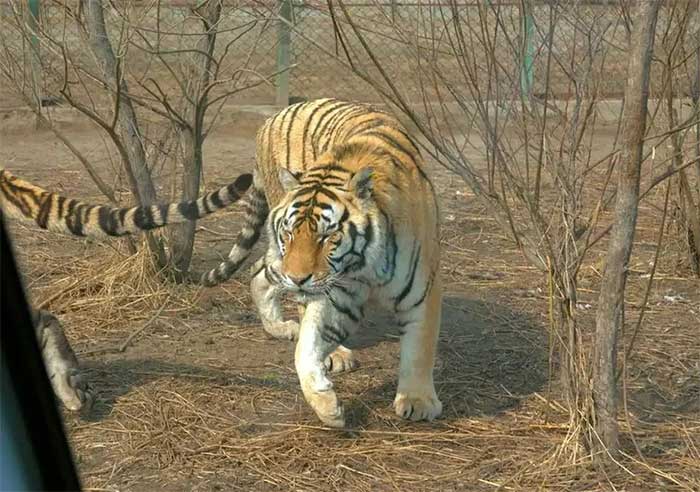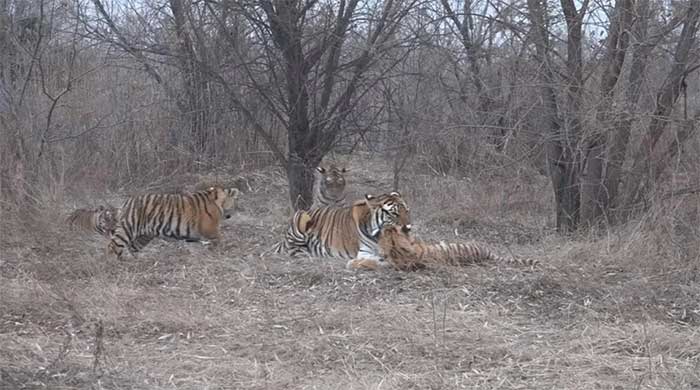As the population of wild Siberian tigers increases, sightings of these tigers encroaching into human activity areas are becoming more frequent.
There are four tiger species currently present in China: South China tiger, Siberian tiger, Bengal tiger, and Indochinese tiger. Over time, the Siberian tiger has become the most important wild tiger species in China, primarily residing in border areas such as Jilin and Heilongjiang, with a population of approximately 60 individuals.
Compared to previous years, sightings of wild Siberian tigers in China have become more common in Jilin and Heilongjiang provinces, and related records are also on the rise.
Local residents report that they have grown accustomed to the presence of wild tigers, and as tiger sightings become more frequent, the fear among the populace has gradually diminished. When tigers come down from the mountains, they sometimes roam freely and hunt poultry and livestock.

The Siberian tiger has become the most important wild tiger species in China. (Illustrative image).
Wild Animals Descend from the Mountains, Livestock in Danger
Since early November, numerous incidents have occurred in Heilongjiang involving Siberian tigers descending from the mountains to hunt livestock. Notably, a Siberian tiger appeared in Yilan County for two consecutive days, killing two cows belonging to villagers. A local resident in Hulin who owned a dog also had their dog killed by a Siberian tiger overnight; when villagers woke up to feed the dog in the morning, they found it dead, with nearly all of its body gone, leaving just the head.
The Siberian tiger is the largest tiger species still existing on our planet. Many individuals can weigh over 180 kg when fully grown. They are also very powerful and can easily prey on domestic animals such as livestock, sheep, and dogs.
The Siberian tiger is the top predator in forest ecosystems, characterized by its large size and significant appetite, thus its preferred prey consists mainly of medium to large animals.
Moreover, the success rate of their hunts is about 24%, which is not high, so instead of expending a lot of time and energy hunting small animals, targeting medium and large prey is clearly more energy-efficient.
A study in the Sikhote-Alin mountain range indicated that the top three prey species for Siberian tigers are red deer, wild boars, and roe deer, all of which are not small in size. Therefore, domestic animals such as livestock and sheep fall within the hunting preferences of the Siberian tiger, making them vulnerable when the tigers come down from the mountains in search of food.
Tigers Become More Aggressive in Winter
Regarding the phenomenon of tigers descending from the mountains, it predominantly occurs in the winter, compared to other seasons. Siberian tigers are more likely to come down in search of food during winter; why is this the case?
In fact, this is related to the environment. As winter arrives, temperatures drop significantly, and the Northeast of China experiences heavy snowfall, covering the ground with thick snow, prompting wild animals that usually inhabit deeper mountainous areas and old forests to move down from the mountains.
Thus, in winter, the range of activity for Siberian tigers increases, and they frequently come into contact with the fringes of their territory, which overlaps with human activity areas.

Siberian tigers frequently come down for food in winter. (Illustrative image).
Siberian tigers prefer to descend for hunting in winter, which is also related to their hunting strategy, as during the autumn and winter, their hunting approach becomes more aggressive.
Tigers are very cautious and typically target less dangerous hoofed animals. In autumn and winter, Siberian tigers change their foraging strategy and may even seek out and attack brown bears when hungry.
Based on analyses of prey preferences and fecal composition, scientists have found that bears account for 7.1% of their diet. This more aggressive hunting strategy also leads to Siberian tigers descending to hunt for food more frequently in winter.
Increasing Population of Siberian Tigers Year by Year
Besides seasonal factors, there is an undeniable reality that the number of wild Siberian tigers in China is increasing year by year. When the pilot project for the Siberian Tiger and Leopard National Park began in 2017, the wild Siberian tiger population in China stood at just 27. By World Tiger Day in 2020, data from the Chinese Forestry Administration and Grassland Administration indicated that the population of Siberian tigers had risen to about 60 individuals. Now, three years have passed, and we have reason to believe that this number has continued to increase.

The number of wild Siberian tigers in China is increasing year by year. (Illustrative image).
In addition to natural reproduction, there is another way for the population of wild Siberian tigers in China to increase: continuous migration of Siberian tigers from Russia. In fact, there have been two large-scale migrations of Siberian tigers in history:
The first occurred in the first half of the 20th century. In the late 19th century, Russia began large-scale hunting of tigers, leading to a significant number of Siberian tigers being killed, some of which fled to China. It was not until 1947 that Russia issued a complete ban on hunting Siberian tigers.
The second occurred in the second half of the 20th century. After the 1950s, China also began large-scale hunting of tigers, resulting in a sharp decline in the wild tiger population and the South China tiger disappearing from the wild. During this period, some Siberian tigers that had moved from China returned to Russia through ecological corridors, allowing the population of Siberian tigers in Russia to recover rapidly in a short time.

Siberian tigers continuously migrate from Russia to China. (Illustrative image).
In 1977, China declared comprehensive protection for Siberian tigers; however, due to prolonged hunting and habitat destruction, the population of wild Siberian tigers in the country has been very rare and difficult to recover for a long time. In recent years, however, the country has actively implemented ecological environment construction and wildlife protection efforts, while continuing to restore the ecological corridors between China and Russia, laying the groundwork for the third migration of Siberian tigers.
On one hand, as the ecological environment improves, on the other hand, the population of wild Siberian tigers in Russia is slowly approaching environmental carrying capacity. Compared to the inland areas of Siberia, which have not had tigers since ancient times, the forests and snowfields in Northeast China remain the only places where Siberian tigers exist.
The third large-scale migration of Siberian tigers has occurred quietly, such as in January 2019, when a female tiger and three cubs were filmed migrating from Russia. The female tiger during the nurturing phase has very strict environmental requirements and does not migrate far unless necessary.
As the population of wild Siberian tigers continues to grow, they will descend from the mountains in search of food more frequently. People should avoid contact with them, taking care not to disturb or harm them. More importantly, we need to actively seek solutions to conflicts between humans and animals, as this is a challenging issue worldwide.





















































